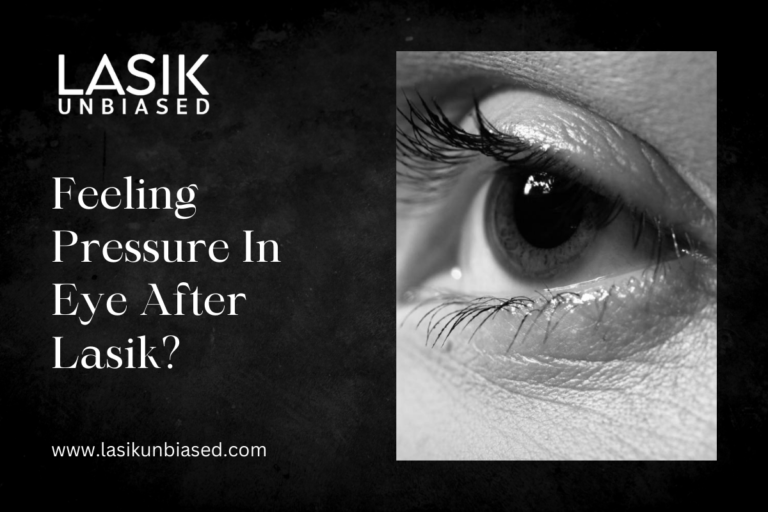LASIK surgery is a highly effective and commonly performed procedure for correcting vision. While most patients recover smoothly, some may experience unusual sensations, including pressure in the eye.
This sensation can range from mild discomfort to a more noticeable tightness, leading to concerns about the healing process. Understanding the causes of eye pressure after LASIK, how to manage it, and when to seek medical advice can help ensure a safe and comfortable recovery.
What Causes Eye Pressure After LASIK?
Feeling pressure in the eye after LASIK can be attributed to several factors, most of which are temporary and part of the normal healing process. However, in some cases, persistent or increasing pressure may indicate an underlying issue that requires medical attention.
One common cause is post-surgical inflammation. LASIK involves creating a corneal flap, and the eye naturally responds to this process with inflammation. Mild swelling can lead to a sensation of pressure, which usually subsides as the healing progresses.
Another major factor is temporary changes in intraocular pressure (IOP). During LASIK, a suction device stabilizes the eye, which can cause a short-term increase in eye pressure. Additionally, some post-surgery medications, particularly steroid eye drops, can lead to a rise in IOP. While this increase is usually temporary, it can cause a noticeable feeling of pressure, especially if the body is slow to regulate the pressure back to normal levels.
Dry eye syndrome is another common post-LASIK condition that can contribute to discomfort, including a sensation of tightness or pressure in the eye. LASIK temporarily affects the corneal nerves responsible for tear production, leading to dryness, irritation, and sometimes a feeling of pressure.
In some cases, corneal swelling can occur after LASIK, which may create a sensation of pressure or fullness in the eye. This usually resolves as the cornea stabilizes in the weeks following the surgery.
Although rare, flap complications can also lead to pressure or discomfort. If the corneal flap does not heal properly or shifts from its original position, it can create an abnormal sensation in the eye.
How Long Does the Feeling of Pressure Last?
For most patients, the sensation of pressure in the eye after LASIK is temporary and resolves within a few days to a couple of weeks. Mild pressure caused by inflammation or suction-related changes in intraocular pressure typically subsides within the first few days.
Dry eye-related discomfort, including a sensation of tightness or pressure, can persist for several weeks or months. However, as the nerves in the cornea regenerate and tear production improves, this symptom should gradually diminish.
If the sensation of pressure persists for more than a few weeks or worsens over time, it is essential to consult an ophthalmologist. Prolonged or increasing pressure may indicate an issue, such as elevated intraocular pressure or an underlying complication that requires medical attention.
How to Relieve Eye Pressure After LASIK
Managing the sensation of pressure in the eye after LASIK involves following proper post-operative care instructions and using recommended treatments to alleviate discomfort. Several strategies can help reduce this sensation and promote a smoother recovery.
Lubricating eye drops is one of the most effective ways to relieve eye pressure. Dryness can contribute to a sensation of tightness or discomfort, and keeping the eyes well-moisturized can reduce irritation. Preservative-free artificial tears are often recommended for post-LASIK patients to help maintain eye hydration.
Following the prescribed medication regimen is also crucial. While steroid eye drops may contribute to increased eye pressure in some cases, they are essential for reducing inflammation and promoting healing. If pressure-related discomfort persists, an ophthalmologist may adjust the medication to minimize side effects while ensuring proper recovery.
Limit screen time during the initial recovery period to minimize strain on the eyes. Extended use of digital devices can exacerbate dryness and eye fatigue, increasing the feeling of pressure. Wearing sunglasses when outdoors can also be beneficial. Bright light and glare can increase eye sensitivity and discomfort, making pressure sensations more noticeable. Sunglasses with UV protection can shield the eyes and help them adjust more comfortably post-surgery.
Staying hydrated is another simple yet effective way to support healing and maintain proper eye function. Drinking enough water helps with tear production and reduces dryness, which can contribute to pressure-related discomfort.
Patients should also avoid rubbing their eyes during the recovery period. Applying pressure to the eyes can disrupt the healing corneal flap and lead to complications. If the sensation of pressure becomes uncomfortable, using artificial tears or gently closing the eyes for a few moments can provide relief.
For individuals experiencing persistent pressure due to increased intraocular pressure, an ophthalmologist may recommend medicated eye drops specifically designed to lower IOP. These drops can help regulate pressure levels and alleviate discomfort.
When to Seek Medical Attention
While mild pressure is a common post-LASIK symptom, warning signs may indicate a more serious issue. It is essential to contact an ophthalmologist if:
- The pressure sensation becomes severe or persistent beyond the expected healing period.
- There is a sudden increase in eye discomfort or pain.
- Vision becomes blurry, distorted, or fluctuates unexpectedly.
- There is redness, swelling, or discharge from the eye.
- Light sensitivity becomes severe and does not improve.
- Halos, glare, or starbursts around lights worsen over time.
These symptoms may indicate complications such as increased intraocular pressure, corneal swelling, or flap-related issues that require immediate evaluation. Early detection and intervention can prevent further complications and ensure a successful recovery.
Proper post-operative care, including lubricating eye drops, limiting screen time, wearing sunglasses, and staying hydrated, can help relieve discomfort. However, if pressure persists or worsens, it is essential to seek medical attention to rule out complications. With careful monitoring and adherence to recovery guidelines, patients can expect to enjoy clear vision and a successful LASIK outcome.


